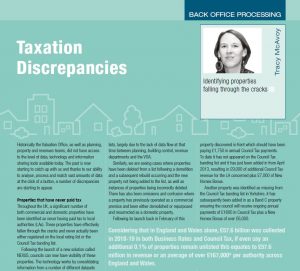 First Published in IRRV Insight May 2020 edition
First Published in IRRV Insight May 2020 edition
Historically, the Valuation Office, as well as planning, property and revenues teams did not have access to the level of data, technology and information sharing tools available today. The past is now starting to catch up with us and thanks to our ability to analyse, process and match vast amounts of data at the click of a button a number of discrepancies are starting to appear.
Properties that have never paid tax
Throughout the UK, a significant number of both commercial and domestic properties have been identified as never having paid tax to Local Authorities. These properties have effectively fallen through the cracks and never actually been either registered on the local rating list or the council tax banding list.
Following the launch of a new solution called NEXUS, Councils can now have visibility of these properties. The technology works by consolidating information from a number of different datasets such as electronic property listings and directories and, using mapping software, cross referencing this against a Councils current rating list or council tax banding list, to identify discrepancies. So a Council will effectively be presented with a set of properties which may appear on online directories or listings but be absent on their local council tax banding list or rating list. Upon further investigation Councils are often finding that these properties are not paying tax because nobody knew they existed or knew to bill them.
Considering that in England and Wales alone, £57.6 billion was collected in 2018-19 in both business rates and council tax, if even say an additional 0.1% of properties remain unlisted this equates to £57.6 million in revenue or an average of over £167,000* per Authority across England and Wales.
Missing assessments and properties dating back to the 1990’s
Initial research using NEXUS, indicates that properties built and developed as far back as 25 to 30 years ago have not been included in local lists, largely due to the lack of data flow at that time between planning, building control, revenue departments and the VOA.
Similarly, we are seeing cases where properties have been deleted from a list following a demolition and a subsequent rebuild occurring and the new property not being added to the list as well as instances of properties being incorrectly deleted. There has also been omissions and confusion where a property has previously operated as a commercial premise and been either demolished or repurposed and resurrected as a domestic property.
Following its launch back in February of this year, 25 Local Authorities have already signed up to use the NEXUS solution as a means to identify these non-tax paying properties and generate additional revenue. Deborah Davies, Revenues Manager from Craven District Council comments “We’ve only been using NEXUS for a month or so but already we’ve uncovered a couple of small businesses and a very large domestic property. We’ve also had the opportunity to tidy up our databases and to bring them back into line with the VOA. We’re delighted that NEXUS has already paid for itself.”
The fact that it is purchased on an annual subscription basis and is not a commission-based solution ensures that quite quickly Councils can see a substantial return on investment and are entitled to keep all additional revenue they identify.
Additional revenue generation through New Homes Bonus
A number of Local Authorities using the system have also been able to collect additional New Homes Bonus revenue through the identification of previously unlisted properties. A recent example of this came from a property discovered in Kent which should have been paying £1,750 in annual council tax payments. To date it has not appeared on the council tax banding list and it has just been added in from April 2013, resulting in £9,000 of additional council tax revenue for the Local Authority concerned plus £7,000 of New Homes Bonus.
Another property was identified as missing from the council tax banding list in Yorkshire, it has subsequently been added in as a Band C property ensuring the council will receive ongoing annual payments of £1600 in council tax plus a New Homes Bonus of over £6,000.
It’s not all just about revenue generation as Craven District Council point out, it’s about having accurate information about your local properties and ensuring this is reflected in the data held by the Valuation Office. It also helps prevent delays in information sharing when it comes to new builds, ensuring new properties can be brought into taxation more quickly without being overly reliant on your planning or property teams.
Conclusion
This technology lays the groundwork for being able to identify properties that have to date remained hidden. Once we start consolidating customer feedback on what they have uncovered and add our own results from the Councils whom have opted for a managed service approach, we will have a much clearer understanding as to the size and scale of missing properties across the UK.
